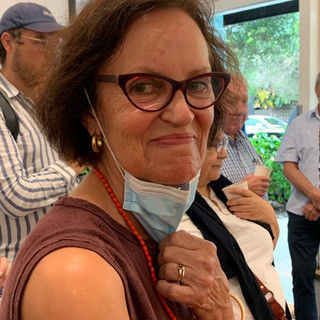Winning the Climate Wars
- Zoe Reynolds
- Mar 7, 2022
- 4 min read
Updated: Mar 12, 2022

Greg Combet AM, Minister for Climate Change under the Gillard Government, now chair of a $189B investment fund, is optimistic that the move to renewable energy is now unstoppable.
Opening an exhibition on the horrific impact of the climate-driven mega fires of Black Summer 2019-2020, and the renewal under way, Combet said he believed change was happening.
“I am really optimistic about the future,” he told the gathering of around 30 at the opening of the Black Summer exhibition by local photographer Zoe Reynolds at Gallery East in Sydney’s eastern suburbs on March 3.
“I was pretty down when I left parliament,” Combet said. “I felt I’d let people down because we didn’t make reforms that were sustainable. But fast forward to today I reckon it’s just an unstoppable momentum that we are going to bring about change. The electricity system is transforming from coal fired to renewable energy.”
Combet spoke about the climate crisis, his personal experience as minister at the height of Australia’s climate wars and the importance of acting now.
Discussing why the Labor government was unable to succeed at the time, Combet said it was up against powerful institutions, particularly the fossil fuel companies that fought very hard to defend their interests and their profits.
But more importantly Combet stressed that in a democracy we have to persuade people, especially in regions where communities rely on coal, about the need for change, the science of climate change, and that they will have alternate jobs.
“We were probably a little bit ahead of our time in making a big change,” he said. “In a democracy like ours, you have to win votes, you have to pay attention to people’s fears and concerns.”
The Black Summer fires were a turning point in our history, he said.
“So many people around the country realised what climate change can do,” Combet said. “You can see it out there now. The second summer in a row we’ve had extraordinary levels of rainfall and, again, with fatal consequences.”
Combet now chairs IFM Investors, a global investment manager for around 600 of Australia’s not-for-profit industry superannuation funds and international pension funds, investing on behalf of tens of millions of workers. It is investing in infrastructure, like NSW Ports, focussing on sustainable investment strategies.
“We have investments all over the world and we have developed plans to drive them all to net zero,” he said.
Also known as ‘workers’ capital’ the fund is one of many at the forefront of the push for renewable energy.
Combet also highlighted how artists can impact on the climate crisis.
“Art has a very important role in our society to win people over and get them thinking about a cause and why there is a need for change,” he said, congratulating Reynolds on her commitment to the environment as an artist and an activist.
The Role of the Artist

Greg Weight is one of Australia’s foremost photographers whose work spans half a century and hangs at Australian Galleries, the National Portrait Gallery, National Library and National Gallery. He also highlighted the need for artists to speak out.
“Artists are in the best position to speak loudly about the impact of climate change with a well-informed scientific backdrop,” he said. “Artists today are not concerned by the status quo and can work experimentally and radically outside top-down propaganda. Zoe is one of those artists. This exhibition is totally in step with contemporary art.”
Weight described her work as an unflinching look at the aftermath of a catastrophic disaster on wildlife and wilderness.
“Black Summer is a carefully considered exhibition,” he said, “Bringing in a Tribal Warrior for a smoking ceremony and the voices of tomorrow with other children’s art into the gallery and thankfully some hope for the future.”
The images of regrowth (Phoenix Bloom, above) were the masterpieces of this exhibition, photographed a few weeks after the fires passed through, he said.
“Zoe deliberately framed them in the camera so that later she could position the scorched trunk of each regrowth in a vase creating still life – literally a still alive,” he said. “She then selectively painted onto the photographic image. Which in turn made each an original artwork.”
“I congratulate Zoe wholeheartedly on her vision, her technique and for speaking out,” he said.
The Island of the Dead
Zoe Reynolds spoke of how Kangaroo Island was known by the Kaurna First Nation people as the Island of the Dead after rising sea levels forced their migration to the mainland around 10,000 years ago and the many women kidnapped as sex slaves by sealers during colonial times who drowned attempting their escape to the mainland. After the fires burnt half the island to the ground in 2020 Kangaroo Island once again became the Island of the Dead.
An estimated 3B animals were lost in the path of the flames nationwide that Black Summer, according to a report commissioned by the World Wildlife Fund. It warned of mass extinction. Of the estimated 61,000 kolas lost, more than half perished on Kangaroo Island.
The most recent Intergovernmental Panel on Climate Change (IPCC) report released in February provides “a dire warning about the consequences of inaction” and the narrowing window to act.
Remarkably, regeneration of wildlife alongside the regrowth in Kangaroo Island is underway. Volunteer “online eco warriors” across the globe are tracking the endangered dunnart marsupial mice and other native fauna thought lost to the fires via motion detection cameras from their home computers.
“Some of my images are confronting,” said Reynolds. “But I have endeavoured to balance that with the disturbing beauty of Phoenix Blooms. There is still a window to act. I hope this exhibition helps inspire that.”
Speeches in full are on YouTube
BLACK SUMMER: Kangaroo Island After the Fires, Gallery East, 21 Burnie St, Clovelly, March 3-13, Thurs-Sunday, 11am-6pm.
CAPTIONS: (left to right) Greg Combet & Zoe Reynolds, Bella Tjut, Lola & Rothko (family & fellow artists), Lola & Rothko pose in front of their artwork "Smoke & Fire", Greg Weight, MC, photographer & GalleryEast host, Zoe & family, Rowena Walsh, Tribal Warrior & Carol Ruff, artist, runs Gallery East with Greg Weight.
PHOTO CREDITS: Carol Ruff (top), Sandy Edwards, Bella Tjut, Eben Miller



















































Comments